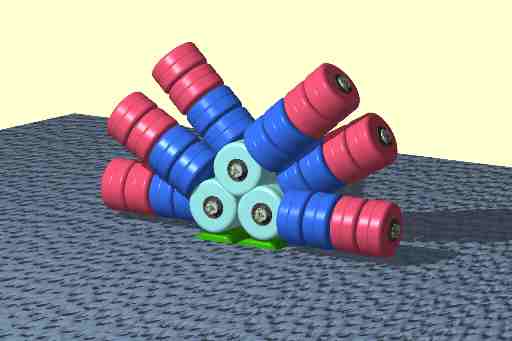|
Phycoerythrocyanin
Phycoerythrocyanin is a kind of phycobiliprotein, magenta chromoprotein involved in photosynthesis of some Cyanobacteria. This chromoprotein consists of alpha- and beta-subunits, generally aggregated as hexamer. Alpha-phycoerythrocyanin contains a phycoviolobilin, a violet bilin, that covalently attached at Cys-84, and beta-phycoerythrocyanin contains two phycocyanobilins, a blue bilin, that covalently attached at Cys-84 and -155, respectively. Phycoerythrocyanin is similar to phycocyanin, an important component of the light-harvesting complex (phycobilisome) of cyanobacteria and red algae. While only phycocyanobilin is covalently bound to phycocyanin Phycocyanin is a pigment-protein complex from the light-harvesting phycobiliprotein family, along with allophycocyanin and phycoerythrin. It is an accessory pigment to chlorophyll. All phycobiliproteins are water-soluble, so they cannot exist ..., leading to an absorption maximum around 620 nm, phycoerythrocyanin containing both ... [...More Info...] [...Related Items...] OR: [Wikipedia] [Google] [Baidu] |
Phycobilisome
Phycobilisomes are light-harvesting antennae that transmit the energy of harvested photons to photosystem II and photosystem I in cyanobacteria and in the chloroplasts of red algae and glaucophytes. They were lost during the evolution of the chloroplasts of green algae and plants. General structure Phycobilisomes are protein complexes (up to 600 polypeptides) anchored to thylakoid membranes. They are made of stacks of chromophorylated proteins, the phycobiliproteins, and their associated linker polypeptides. Each phycobilisome consists of a core made of allophycocyanin, from which several outwardly oriented rods made of stacked disks of phycocyanin and (if present) phycoerythrin(s) or phycoerythrocyanin. The spectral property of phycobiliproteins are mainly dictated by their prosthetic groups, which are linear tetrapyrroles known as phycobilins including phycocyanobilin, phycoerythrobilin, phycourobilin and phycobiliviolin. The spectral properties of a given phyco ... [...More Info...] [...Related Items...] OR: [Wikipedia] [Google] [Baidu] |
Phycobiliprotein
Phycobiliproteins are water-soluble proteins present in cyanobacteria and certain algae (rhodophytes, cryptomonads, glaucocystophytes). They capture light energy, which is then passed on to chlorophylls during photosynthesis. Phycobiliproteins are formed of a complex between proteins and covalently bound phycobilins that act as chromophores (the light-capturing part). They are most important constituents of the phycobilisomes. Major phycobiliproteins Characteristics Phycobiliproteins demonstrate superior fluorescent properties compared to small organic fluorophores, especially when high sensitivity or multicolor detection required : * Broad and high absorption of light suits many light sources * Very intense emission of light: 10-20 times brighter than small organic fluorophores * Relative large Stokes shift gives low background, and allows multicolor detections. * Excitation and emission spectra do not overlap compared to conventional organic dyes. * Can be used in tandem (si ... [...More Info...] [...Related Items...] OR: [Wikipedia] [Google] [Baidu] |
Photosynthesis
Photosynthesis ( ) is a system of biological processes by which photosynthetic organisms, such as most plants, algae, and cyanobacteria, convert light energy, typically from sunlight, into the chemical energy necessary to fuel their metabolism. ''Photosynthesis'' usually refers to oxygenic photosynthesis, a process that produces oxygen. Photosynthetic organisms store the chemical energy so produced within intracellular organic compounds (compounds containing carbon) like sugars, glycogen, cellulose and starches. To use this stored chemical energy, an organism's cells metabolize the organic compounds through cellular respiration. Photosynthesis plays a critical role in producing and maintaining the oxygen content of the Earth's atmosphere, and it supplies most of the biological energy necessary for complex life on Earth. Some bacteria also perform anoxygenic photosynthesis, which uses bacteriochlorophyll to split hydrogen sulfide as a reductant instead of water, p ... [...More Info...] [...Related Items...] OR: [Wikipedia] [Google] [Baidu] |
Cyanobacteria
Cyanobacteria ( ) are a group of autotrophic gram-negative bacteria that can obtain biological energy via oxygenic photosynthesis. The name "cyanobacteria" () refers to their bluish green (cyan) color, which forms the basis of cyanobacteria's informal common name, blue-green algae. Cyanobacteria are probably the most numerous taxon to have ever existed on Earth and the first organisms known to have produced oxygen, having appeared in the middle Archean eon and apparently originated in a freshwater or terrestrial environment. Their photopigments can absorb the red- and blue-spectrum frequencies of sunlight (thus reflecting a greenish color) to split water molecules into hydrogen ions and oxygen. The hydrogen ions are used to react with carbon dioxide to produce complex organic compounds such as carbohydrates (a process known as carbon fixation), and the oxygen is released as a byproduct. By continuously producing and releasing oxygen over billions of years, cyanobacte ... [...More Info...] [...Related Items...] OR: [Wikipedia] [Google] [Baidu] |
Phycocyanin
Phycocyanin is a pigment-protein complex from the light-harvesting phycobiliprotein family, along with allophycocyanin and phycoerythrin. It is an accessory pigment to chlorophyll. All phycobiliproteins are water-soluble, so they cannot exist within the membrane like carotenoids can. Instead, phycobiliproteins aggregate to form clusters that adhere to the membrane called phycobilisomes. Phycocyanin is a characteristic light blue color, absorbing orange and red light, particularly 620 nm (depending on which specific type it is), and emits fluorescence at about 650 nm (also depending on which type it is). Allophycocyanin absorbs and emits at longer wavelengths than phycocyanin C or phycocyanin R. Phycocyanins are found in cyanobacteria (also called blue-green algae). Phycobiliproteins have fluorescent properties that are used in immunoassay kits. Phycocyanin is from the Greek ''phyco'' meaning “algae” and ''cyanin'' is from the English word “cyan", which convention ... [...More Info...] [...Related Items...] OR: [Wikipedia] [Google] [Baidu] |


